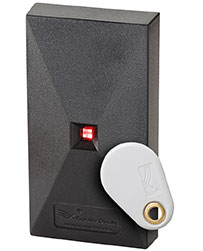 If wireless solutions are not on your radar for access control installations, it's time to take notice of this growing trend in physical security. Such solutions let integrators and end users reap the benefits of a wired system, without the cost of a hardwired system. Implementing a wireless solution often takes less time than its traditional hardwired counterpart. When retrofitting older buildings with new access control systems, wireless systems may literally be the only viable option available.
If wireless solutions are not on your radar for access control installations, it's time to take notice of this growing trend in physical security. Such solutions let integrators and end users reap the benefits of a wired system, without the cost of a hardwired system. Implementing a wireless solution often takes less time than its traditional hardwired counterpart. When retrofitting older buildings with new access control systems, wireless systems may literally be the only viable option available.
Wireless readers are not just used for doors - wireless solutions exist for elevators, exit devices, and gates. Wireless systems work with most of today's access control systems. That means users don't have to replace their existing ID credentials. Such systems are an attractive alternative to off-line, standalone locking systems, because they offer a real-time solution that's compatible with nearly all brands of access control.
And, in today's world of chronically short time and money budgets, wireless solutions work particularly well for airports, marinas, schools and universities, healthcare institutions and corporate facilities.
When Going Wireless Makes Most Sense
Truly, wireless systems could be applied anywhere a lock is installed, but there are certain applications that lend themselves particularly well to wireless. Older buildings that would be difficult or impossible to hardwire come to mind. Whether they are installed in new modern buildings or historical landmarks, however, wireless locking systems preserve the integrity of the architectural design. Another plus - potential asbestos issues are avoided entirely.
While wireless locksets work equally well on wood and metal doors, both interior and exterior, there are several other wireless applications as well. These include glass, monitored and scheduled doors, gates and portable solutions.
Elevators are another prime candidate for wireless systems. Traveling cables are routinely included at the time on installation, yet they are often ill equipped to reliably transport credential data from the cab to the elevator controller. Elevator shafts are harsh electrical environments and are often the source of data corrupting noise that becomes induced onto the card reader data lines. This causes inconsistent performance, which often gets worse over time as cable shielding decays due to continual movement.
Conversely, wireless solutions eliminate the need for the data lines in elevators. In fact, they thrive in this environment and provide consistent, reliable data transport that doesn’t wear out. Wireless alternatives can save thousands of dollars per elevator.
The Wireless Way
Wireless locking solutions provide the same online, real-time capabilities as wired systems. Access privilege changes and audit records are available at the central control terminal, all from a common database, which simplifies data entry and management. This also eliminates the need to go door to door to upload changes and download records making wireless locksets a good alternative to off-line, standalone locking systems. In addition, all wireless transmissions are typically encoded and may use AES128-bit private keys for heightened security.
For security integrators and end users, wireless locking systems offer an opportunity to solve problems that might once have been impossible or impractical. It may be counterintuitive, but you don't need line of sight. Wireless RF signals are able to penetrate cinder block walls, plasterboard walls, brick walls and many other non-metallic materials for simplified system designs and implementations.
For outdoor applications, like vehicle and pedestrian gate access, wireless links can often bridge up to 285 feet, eliminating costly trenching. Wireless systems are ideal for garages, harbors, parking lots, airports, utility companies and military bases. They are especially cost effective for controlling gates around a facility. Even more impressive - optional directional or gain antennae are available for still longer distances, such as an installation at a Middle East oil field where gates may be controlled from thousands of feet away.
The value proposition for implementing wireless systems in a wide variety of networked openings is compelling. Real-life installations prove that a reliable wireless solution can have a substantially lower installed cost than its wired alternative. What's more, wireless systems use less hardware and install between five to ten times faster. Even in situations that might once have seemed impossible, retrofitting electronic access control systems is now made easy and affordable with wireless access control.